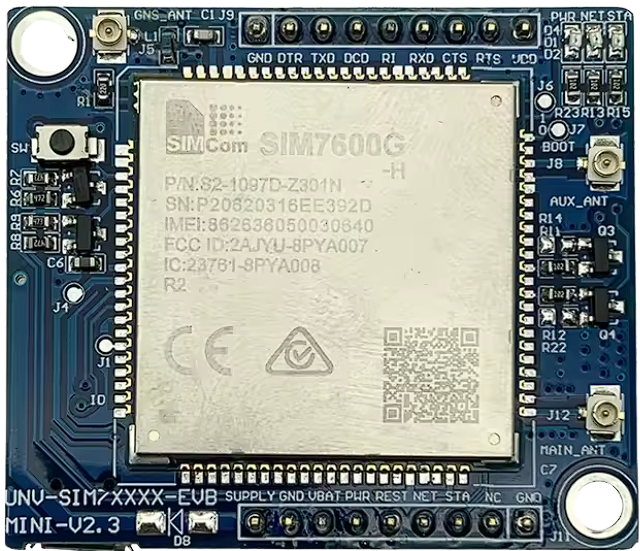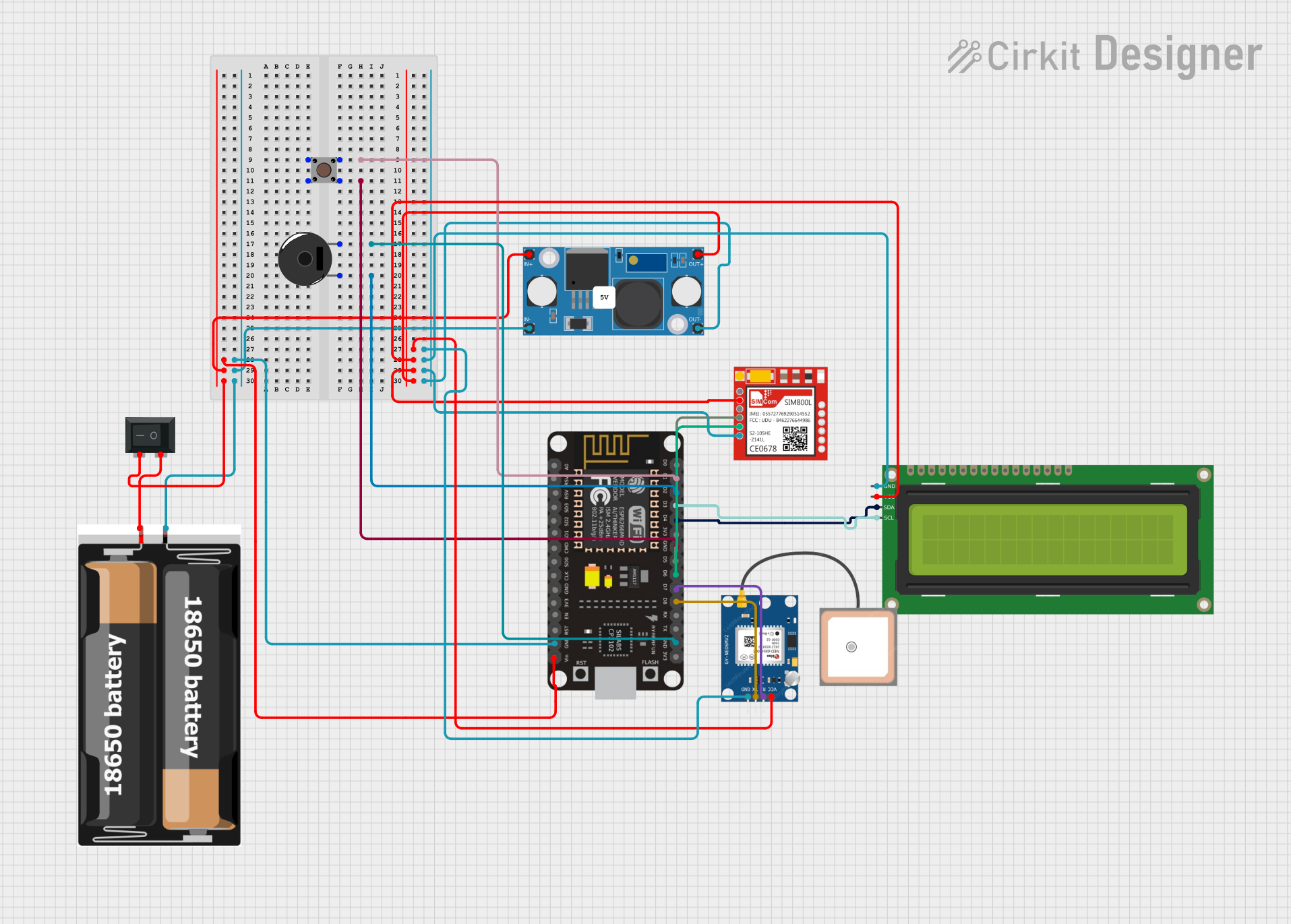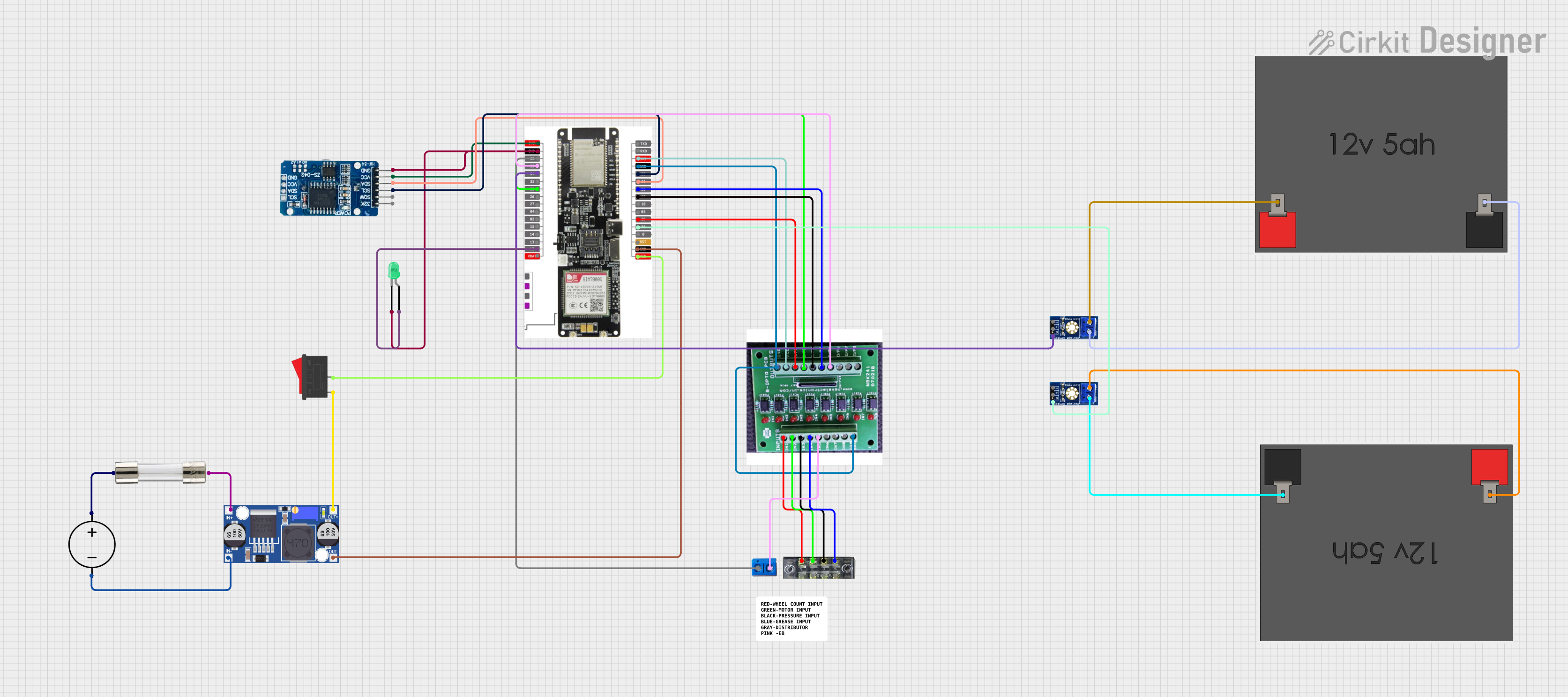
How to Use SIM7600G-H: Examples, Pinouts, and Specs

 Design with SIM7600G-H in Cirkit Designer
Design with SIM7600G-H in Cirkit DesignerIntroduction
The SIM7600G-H is a 4G LTE module manufactured by SIMCOM. It supports a wide range of communication protocols, including GSM, GPRS, HSPA+, and LTE, making it a versatile solution for IoT applications. This module is designed to provide high-speed data transmission, voice communication, and GPS functionality, making it ideal for applications such as remote monitoring, smart metering, vehicle tracking, and industrial automation.
Explore Projects Built with SIM7600G-H

 Open Project in Cirkit Designer
Open Project in Cirkit Designer
 Open Project in Cirkit Designer
Open Project in Cirkit Designer
 Open Project in Cirkit Designer
Open Project in Cirkit Designer
 Open Project in Cirkit Designer
Open Project in Cirkit DesignerExplore Projects Built with SIM7600G-H

 Open Project in Cirkit Designer
Open Project in Cirkit Designer
 Open Project in Cirkit Designer
Open Project in Cirkit Designer
 Open Project in Cirkit Designer
Open Project in Cirkit Designer
 Open Project in Cirkit Designer
Open Project in Cirkit DesignerCommon Applications
- IoT Devices: Enables reliable communication for smart devices.
- Vehicle Tracking: Provides GPS functionality for fleet management.
- Remote Monitoring: Facilitates data transmission for industrial and agricultural systems.
- Smart Cities: Powers smart metering and environmental monitoring systems.
- Wearable Devices: Supports communication in health monitoring systems.
Technical Specifications
Key Technical Details
| Parameter | Specification |
|---|---|
| Manufacturer | SIMCOM |
| Part Number | SIM7600G-H |
| Communication Protocols | GSM, GPRS, EDGE, WCDMA, HSPA+, LTE |
| LTE Bands | LTE-FDD: B1/B2/B3/B4/B5/B7/B8/B12/B13/B18/B19/B20/B25/B26/B28/B66/B85 |
| GPS Support | Yes (GNSS: GPS, GLONASS, BeiDou, Galileo, QZSS) |
| Data Rate | LTE Cat-4: Uplink 50 Mbps, Downlink 150 Mbps |
| Operating Voltage | 3.4V to 4.2V |
| Power Consumption | Idle: ~1.5mA, Active: ~500mA (varies with network conditions) |
| Operating Temperature | -40°C to +85°C |
| Dimensions | 30.0mm x 30.0mm x 2.9mm |
| Interface | UART, USB 2.0, I2C, GPIO, ADC, PCM |
| Antenna Interfaces | Main Antenna, GNSS Antenna |
| Certifications | CE, FCC, RoHS, PTCRB, GCF |
Pin Configuration and Descriptions
The SIM7600G-H module has multiple pins for communication and power. Below is a summary of the key pins:
| Pin Number | Pin Name | Description |
|---|---|---|
| 1 | VCC | Power supply input (3.4V to 4.2V). |
| 2 | GND | Ground connection. |
| 3 | TXD | UART Transmit Data (for serial communication). |
| 4 | RXD | UART Receive Data (for serial communication). |
| 5 | USB_D+ | USB differential data line (positive). |
| 6 | USB_D- | USB differential data line (negative). |
| 7 | GNSS_TXD | GNSS UART Transmit Data. |
| 8 | GNSS_RXD | GNSS UART Receive Data. |
| 9 | RESET | Reset pin (active low). |
| 10 | PWRKEY | Power-on key (active low, hold for 1 second to power on/off). |
| 11 | ADC_IN | Analog-to-Digital Converter input. |
| 12 | GPIO1 | General-purpose input/output pin. |
Usage Instructions
How to Use the SIM7600G-H in a Circuit
- Power Supply: Connect the VCC pin to a stable power source (3.4V to 4.2V) and the GND pin to ground.
- Serial Communication: Use the TXD and RXD pins for UART communication with a microcontroller or PC.
- USB Interface: Connect the USB_D+ and USB_D- pins to a USB port for data transfer or firmware updates.
- Antenna Connections: Attach a 4G LTE antenna to the Main Antenna port and a GPS antenna to the GNSS Antenna port for optimal performance.
- Power On/Off: Use the PWRKEY pin to turn the module on or off. Hold the pin low for at least 1 second to toggle the power state.
- Reset: If needed, use the RESET pin to restart the module.
Important Considerations and Best Practices
- Power Supply: Ensure a stable power supply with minimal noise to avoid communication issues.
- Antenna Placement: Place antennas away from high-frequency noise sources for better signal quality.
- Firmware Updates: Regularly update the module's firmware to ensure compatibility with the latest networks.
- Heat Management: If used in high-temperature environments, ensure proper ventilation or heat dissipation.
Example: Connecting SIM7600G-H to Arduino UNO
Below is an example of how to connect the SIM7600G-H to an Arduino UNO and send an SMS:
Wiring
| SIM7600G-H Pin | Arduino UNO Pin |
|---|---|
| VCC | 5V (via a voltage regulator) |
| GND | GND |
| TXD | Pin 10 (RX) |
| RXD | Pin 11 (TX) |
| PWRKEY | Digital Pin 9 |
Code
#include <SoftwareSerial.h>
// Define RX and TX pins for SoftwareSerial
SoftwareSerial sim7600(10, 11); // RX = Pin 10, TX = Pin 11
#define PWRKEY 9 // Power key pin
void setup() {
pinMode(PWRKEY, OUTPUT);
digitalWrite(PWRKEY, LOW); // Ensure PWRKEY is low initially
delay(1000);
digitalWrite(PWRKEY, HIGH); // Power on the SIM7600G-H
delay(2000);
digitalWrite(PWRKEY, LOW); // Release PWRKEY
sim7600.begin(9600); // Start communication with SIM7600G-H
Serial.begin(9600); // Start communication with PC
Serial.println("Initializing SIM7600G-H...");
sendCommand("AT"); // Test AT command
sendCommand("AT+CMGF=1"); // Set SMS mode to text
sendCommand("AT+CMGS=\"+1234567890\""); // Replace with recipient's phone number
sim7600.print("Hello from SIM7600G-H!"); // SMS content
sim7600.write(26); // Send SMS (Ctrl+Z)
}
void loop() {
if (sim7600.available()) {
Serial.write(sim7600.read()); // Forward SIM7600G-H responses to Serial Monitor
}
}
void sendCommand(String command) {
sim7600.println(command);
delay(1000); // Wait for the command to execute
}
Troubleshooting and FAQs
Common Issues and Solutions
Module Not Powering On
- Ensure the VCC pin is receiving a stable voltage between 3.4V and 4.2V.
- Check the PWRKEY pin connection and ensure it is held low for at least 1 second.
No Response to AT Commands
- Verify the UART connections (TXD and RXD) between the module and the microcontroller.
- Ensure the baud rate matches the module's default (9600 bps).
Poor Signal Quality
- Check the antenna connections and ensure they are securely attached.
- Place the antennas in an open area away from interference.
GPS Not Working
- Ensure the GNSS antenna is connected and placed in an open area with a clear view of the sky.
- Wait for a few minutes for the module to acquire satellite signals.
FAQs
Q: Can the SIM7600G-H be powered directly from a 5V source?
A: No, the module requires a voltage between 3.4V and 4.2V. Use a voltage regulator if necessary.Q: How do I update the firmware?
A: Use the USB interface to connect the module to a PC and follow the manufacturer's firmware update instructions.Q: What is the maximum data rate supported by the module?
A: The SIM7600G-H supports LTE Cat-4 with a maximum downlink speed of 150 Mbps and uplink speed of 50 Mbps.
This concludes the documentation for the SIM7600G-H module. For further details, refer to the official datasheet provided by SIMCOM.